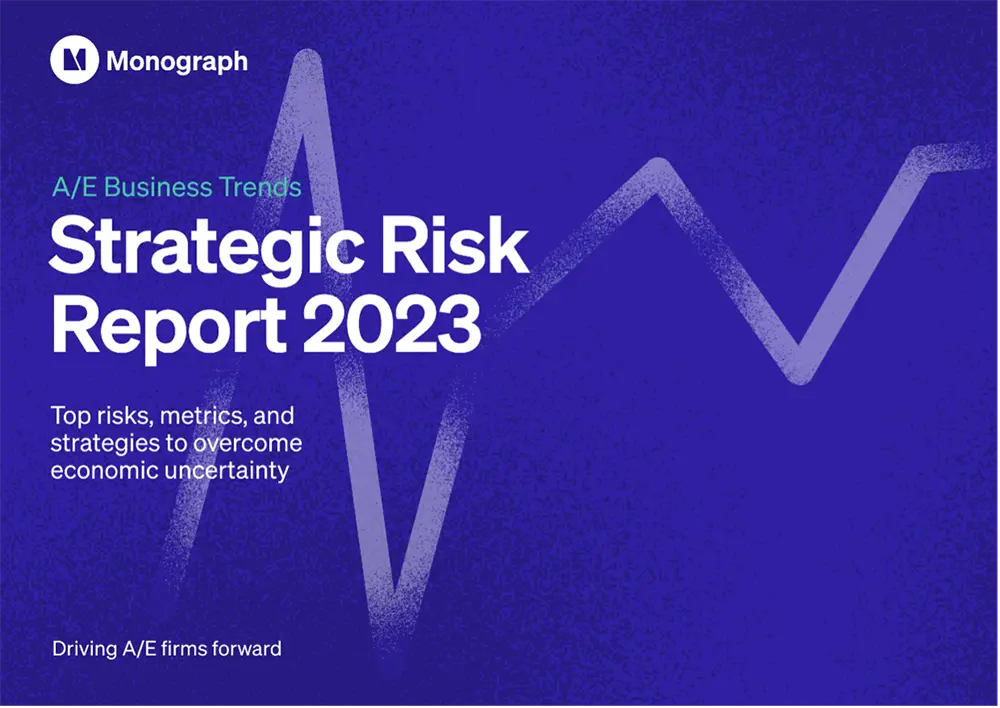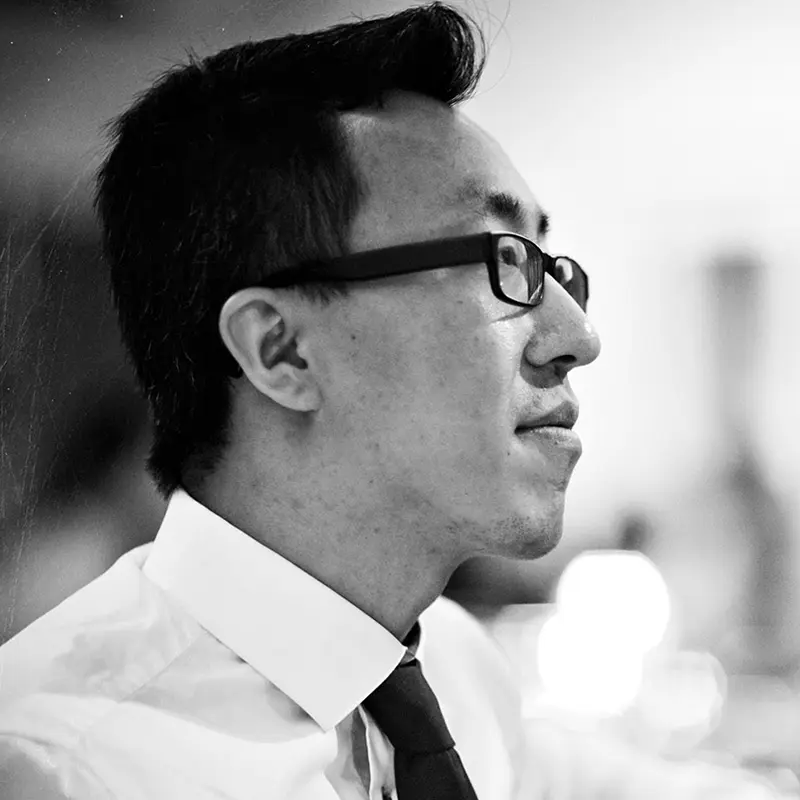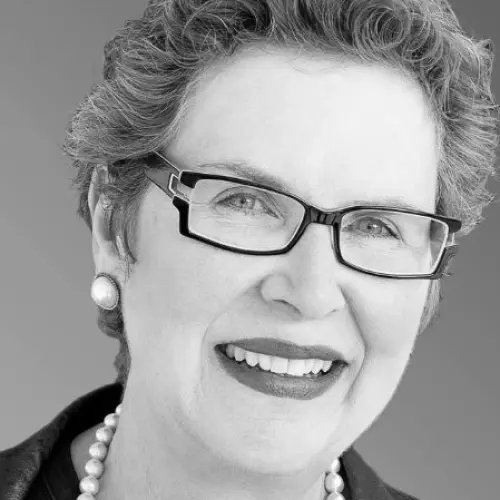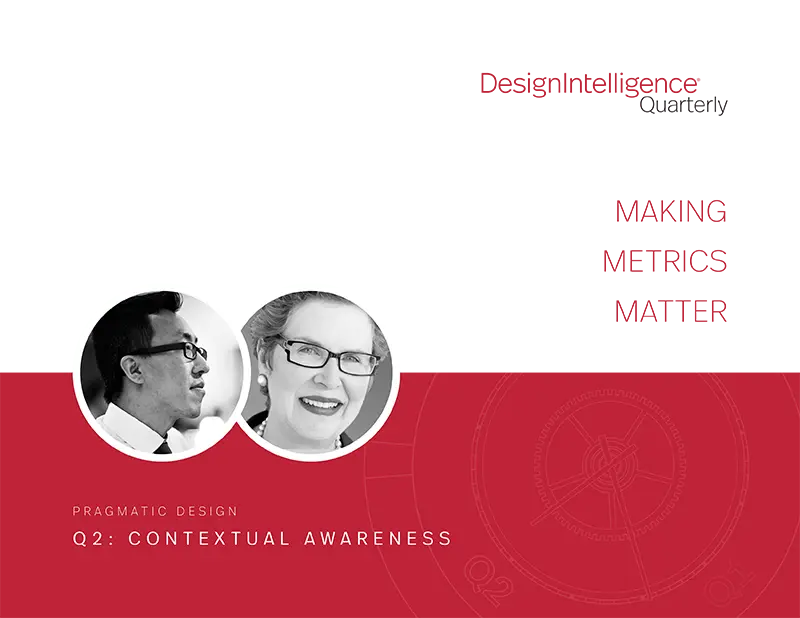Making Metrics Matter
by Robert Yuen
Assoc. AIA, CEO and co-founder of Monograph
& Marjanne Pearson
Founder of Talentstar, Inc.
April 19, 2023
Monograph CEO Robert Yuen and Marjanne Pearson discuss their timely industry report and firm best practices.
DesignIntelligence (DI): We’re talking with Robert Yuen, CEO of Monograph and colleague Marjanne Pearson, Chief Strategy Officer at Talentstar, Inc. Welcome. We just read your recent, excellent, Strategic Risk Report 2023: Top risks, metrics, and strategies to overcome economic uncertainty.
You’ve graciously made it available to all, and we’ve included a link here: Download the Risk Report here.
It seems to dovetail nicely with our current Q2 DI theme of Contextual Awareness. In that light, what motivated you to do this research and share this data?
Robert Yuen (RY): Thank you for having us. We’re glad you found the Strategic Risk Report valuable. Our motivation for conducting this research and sharing the insights comes from our commitment to supporting the architecture and engineering (AE) industry. I was previously an architect. Architects and engineers always need context to design. We need to understand the site. The same is true in business. We need to build context around our businesses. What does the changing landscape in the economy look like? What effect will it have on our clients? By making the report available to all, we aim to foster a more resilient AE community, better equipped to anticipate and embrace the challenges for the future of the built environment industry.
Marjanne Pearson (MP): That’s a great question. What I’ve been hearing consistently from people who’ve read the Monograph report is, “I thought it was just us.” Although so many practice leaders are concerned about similar problems and themes, no one has yet consolidated it into one report for the AEC industry. A place where people could say, “Oh, wow, yes — those are the things I’m dealing with. I’m not alone.” In working with our clients, we’ve been hearing consistent themes regarding the future success and sustainability of their practices— particularly related to talent and business strategies, leadership transition, and ownership succession. We’ve all been going through a period of volatility that began with the pandemic, and it continues with the current economic cycle. Firms are seeking clarity and opportunities to navigate through all kinds of risks they hadn’t really anticipated, as well as all the social changes that have happened beyond our firms. This report helps them understand it’s not just their single firms — it’s affecting the profession.
DI: I’m aware of your primary mission to offer firm management software for tracking internal metrics. To what degree do you look externally to firms, to industry benchmarks and data?
RY: We actively engage with industry leaders, internal and external data sources, and hundreds of Monograph users to understand patterns, challenges, and best practices. For example, in our 2023 Strategic Risk Report we contextualize economic data over the last two decades alongside expertise from AE leaders such as Hemanshu Parwani, “HP”, Principal / Owner and CEO at Olson Kundig and Kimberly Dowdell AIA, NOMAC, 2024 AIA President-elect and Principal at HOK. We use some of these insights to inform how we build our platform. So far, we’ve helped over 800 customers with this data to track and forecast their business performance.
DI: In our Strategic Advisory practice we frequently come alongside firms to coach them to develop the capacity to look externally. Firms get so myopic. Then we suggest that they look to the future, assess what it’s telling them in their own unique ways and develop a plan for how they will respond – or anticipate it. Your report’s conclusion suggests their forming a Futures Council. As we’ve had an AEC industry Design Futures Council for years, we support that idea even on an internal firm scale. Can you talk about your approach to the same function?
MP: Absolutely. I’ve always been impressed with DesignIntelligence and the Design Futures Council. Operationally, most firms develop an annual business plan with a 12-month rolling forecast. In today’s world, that’s not enough. There’s so much more that can be explored. We encouraged our clients to think longer term. AIA had developed the 2030 Commitment, focused on climate strategy, but firm leaders also began to recognize and address justice, equality, diversity, inclusion — JEDI — and other issues we and our clients face. Many of these initiatives were being driven by younger generations, not just the fiduciary leaders.
Before the pandemic, as firms were going global, it became more common for firms to have distributed executive leadership, not all in one headquarter office, but distributed across the firm platform. The pandemic and the adoption of a new world of remote and hybrid working helped practice leadership become more distributed. Firms began to work in hub-and-spoke models rather than hierarchical ones. They also spent more time looking internally at how they were organized, how efficient they were — without necessarily thinking about the changes happening in their client organizations.
Obviously, some firms are ahead of the curve. For years, they have been looking at the future of their market sectors and clients, but this has not been consistent for firms of all sizes and market sectors. It became obvious that for firms to grow and develop, it couldn’t just be the fiduciary leaders doing the planning. Not just the people at the top of the organization. And with the reality of multiple generations within firms, with each generation looking at things with different viewpoints, perceptions and ideas, it begged the question: why wait? Why should someone have to pay their dues for 10 or 15 or 20 years of working within the firm before hearing from them and learning more about what the firm could be doing and dreaming about it.
As my partner Linda Wallack often says, it’s like sitting with your kids at the kitchen table over dinner. The kids have a completely different idea about what could be. We should be taking advantage of all the brainpower we have in ideas-led businesses like architecture, engineering, planning and design to better think about what could be.

DI: Your report mentions the need to prepare for new business development demands to replace lost projects. Beyond metrics and management tools do you get into how to help your clients do that?
RY: You need a strategy for business development in a more competitive climate. To inform that strategy, you first need metrics to assess how well your engine is running today. Forecast the impact of lost projects on your billings, then compare profitability across project types to find which clients to pursue and where to fix inefficiencies. Efficiency is critical because it gives you more time to reinvest into business development. We also offer bi-weekly office hours where AE leaders share what they are doing. Firms are going back-to-basics with in-person, informal lunch meetings with clients to deepen relationships and understand client situations. Some firms are expanding business development beyond principals. By tracking client interactions across their enterprises, firms can be more intentional in designing client experiences that reinforce their brand throughout their projects. Happy clients create more projects.
MP: It’s top-of-mind right now. One of the things I’ve learned over the years — through my work with Nancy Egan and Paul Nakazawa — is that in most firms, 80% of the effort is in getting and doing the work, and 20% is in the strategy of what we really want to do and the best way for us to accomplish that. What we’re trying to do is to shift the focus to the strategy side to create evolutionary change. That’s as opposed to depending on the metabolic side of going after and getting the work without thinking ahead to what the next stage of growth and development might be. That’s the basis for everything that we do — to encourage active participation at all levels of the organization — to understand the strategy for why. Why are we doing what we’re doing? What does that mean for our best clients? How can we create opportunities to connect with them in powerful ways? How can we build relationships? How can we take the lead in creating our future?
There’s a difference in sophistication for firms’ business development. In firms with a strategic marketing and business development (BD) approach, there’s a broader focus on looking ahead, on building competitive advantage, and on ensuring when you go into the arena for a potential project, you have a high probability of winning that project. Something like 80% of architecture firms have 10 or fewer people — a huge percentage don’t have the resources to take advantage of full-time marketing and BD staff. The practitioners are wearing multiple hats and fulfilling the BD function, and doing the best that they can. However, there are resources available now — ways people can learn more about how to be better at building networks and relationships, and communicating why you are the best person for a specific client or opportunity. The biggest issue is not waiting for the right client to come to you but finding a way to create your own networks. That can enhance the perception of your own image and begin to be more strategic about who you’re talking to, why, and what you want to accomplish as a result. There is less time wasted on activities that are simply less productive. This is not saying you shouldn’t go after dreams and after pie-in-the-sky possibilities. And it certainly doesn’t mean phenomenal opportunities won’t come to you as a result of who you are and what you do, and what you’re known for. It’s just a question of intent, strategy, and focus.
DI: Another keen point in your paper, from Angela Brooks, FAIA of AIA Gold Medal Firm Brooks and Scarpa, tells firms to differentiate themselves by thinking like their clients. Sound advice, but how do you achieve it. Getting a traditionally self-focused profession to redirect their thinking is hard.
MP: Yes and no. I can remember back in the day when Art Gensler started his firm. He hired a business professor to help them understand who their client was and how they could work with them. That was not generally well received in the industry. In the early days, there was talk about Gensler not being a real design firm, which was crazy and inappropriate. Nonetheless, the perception existed because they were so focused on their clients. Over the past 50 years, there has been a shift in the AEC industry to add design awards that are client- and market-focused, recognizing that good design is good business. There have always been firms focused on helping clients achieve success on their own terms. Firms in different market sectors have been doing that for years, from CRS back in the day with K-12 projects, to firms working with medical centers and hospitals to re-imagine what healthcare will be in 7-10 years. Because if they don’t, by the time the facilities they’re designing today are built, they’ll be obsolete. So, client focus is not new; it just hasn’t been obvious or prevalent. Today, firms are creating presentations and publications that describe what they do as value propositions with ROI that benefit their clients and their clients’ success.
RY: The best way to learn how to think like your clients is to spend more time with them. For example, I block off 90 minutes on Tuesdays and Thursdays for client calls to learn how to improve Monograph. This is in addition to the full-time work our team spends helping Monograph clients, which includes principals, project managers, finance leaders, and many more AE professionals. Over time, you start to understand how your clients think. Architects and engineers can do the same. In our report, Angela Brooks shared examples of how a design project extends beyond the building. That could mean understanding a client’s underlying goals and property portfolio to identify a development opportunity not originally scoped out by the client. It could mean understanding how client financing affects your project so that you design a smarter services contract. By understanding your client’s context, you can find ways to solve valuable problems for them.
DI: Let’s zoom in. As I understand it, one of Monograph’s software and solution advantages is its smaller scale and ease of use, as compared to other large scale AEC management solutions. Does that also come with an ability to adapt tailored, bespoke versioning? What about services?
RY: Usually bespoke solutions happen because customers are unsatisfied with the existing solutions and legacy software for our industry that was previously designed for a small stakeholder subset, typically the finance team in large firms. No wonder AE leaders are unsatisfied! Instead, Monograph prioritizes a focused, design-driven approach to help all professionals in AE firms effectively track daily progress and forecast their performance. We invest in ease-of-use, extraordinary customer service, and a high velocity of product development to increase adoption across all firm members, which is essential for data accuracy. Based on continuous feedback from hundreds of firms, we have developed a focused solution that finally helps AE firms of varying sizes and business practices to drive their firms forward.
DI: With current concerns about inflation and billings covering costs, you suggest in the report that firms reserve cash to weather the short-term volatility. Balanced against paying bonuses, R&D investment and other choices, are their suggestions to help set priorities?
RY: It is circumstantial based on each firm’s available cash, size, and cash flow situation. As an example, this is not the time to do competitions as they can be costly during economic uncertainty. Priorities should be placed on things that go towards your billings, projects with fees and not competitions. I have seen too many of my friends double down on competitions during rough times, which adds more pressure to the wounds already around them. The right time to do competitions is when market conditions are great, with a large influx of cash and projects, and the firm is growing. Those are the right times to consider R&D investments, or competitions. When the climate is uncertain it is better to be more predictable and stable.
MP: Volatility has been a consistent issue for years. Most firms have developed a client/portfolio/revenue mix that includes repeat business with legacy clients, as well as multi-year revenue contracts. The challenge today is clients that might have been predictable are experiencing their own unexpected volatility. One of the advantages of focusing on strategy in marketing, sales, and investments is the potential ability to pivot — to marshal available resources in more successful ways. I’m thinking about resources like talent, information, networks, and expertise, as well as time and money.
DI: I liked your advice to start with firm rhythms, cadences and billing cycles to set metrics. In Peter-Drucker-like fashion one of your contributors reminds us: “We cannot fix what we are not measuring.” But beyond the tools, systems and processes there is a culture aspect to succeeding. The team must want to. Is that beyond your purview?
RY: It requires a change in behavior. If you already track time and are interested in performance and establishing a baseline, then adopting a performance management tool like Monograph would be easy. If you don’t track time but want to, that’s exciting. Architecture is a team effort. Everyone needs to be on board tracking to establish a baseline. Once they know where they’re starting from, they can make incremental steps toward improvement. Performance management tools are only relevant if you know where you’re starting from. Especially during times of uncertainty, it’s good to get in the habit of understanding where you are today. If you are resistant to change, you have to ask yourself why. If things are not working, do something different. If you don’t even know your baseline, you have to question if what you’re doing now is necessary, and if you need to do more to understand where you are.
MP: It’s even further back than Drucker. It goes back to Abraham Maslow and the hierarchy of needs. And I think that the architectural profession is typically focused on the upper end of the hierarchy of needs — self-actualization, transcendence, etc. — the beauty of the work and how we feel about it. But to succeed, we need to care why we’re doing something, or the reason behind doing something a certain way. Simon Sinek explained it well with The Golden Circle, which many firms are using as part of their management and process modeling, to understand why they’re in business and how that relates to what they do. If everyone in a firm doesn’t understand why it matters, it’s hard to have a culture of success.
In 1997, James Brian Quinn, a professor at Dartmouth’s Tuck School of Business, wrote a book called Innovation Explosion. He was talking about how training dollars were spent. Typically, the highest level was spent on knowing what and how to do things. The least amount was spent on knowing and caring why. But the highest value was in knowing and caring why because that gave us purpose. Over the past five years, purpose has become even more important in all our practices. In many cases, it is driving the younger generations in ways that may not have been the case for my generation (the Boomers). We can’t underestimate the power of communication, understanding and caring why, which means we need to invest in communications as much as we invest in strategy and execution — they are co-equal.
DI: Another angle of attack in your findings was to do more with less. Rebalancing and being more efficient with time. What are your thoughts on looking at growing the pie by increasing revenues through radical new ways of delivering value. We have fought for years against the horrors of simply delivering documents and selling hours. You talk about reinvesting in high value activities. What’s your take?
RY: Architects and engineers are in the unique position of shaping the world we live in. It’s important to constantly remind ourselves as professionals this is what we bring to the world. And it’s important to invest in how we articulate this value to clients. While hours and documents are inputs to designing the built environment, the impact of good design on clients and the world is tremendous. We still see many successful firms working in traditional hourly and fixed fee service models. This is where working with domain experts in marketing and business development can help you reposition the value of your services. It’s also possible you are focusing on the wrong clients. For example, in customer discussions, a firm leader shared that Monograph helped them realize their “bread and butter” projects were not profitable.
MP: I’m not a technology expert, but in the last 10 years, there have been major changes in the way we do stuff. We use new technology every day to simplify our lives. And some days that technology complicates our lives and drives us crazy. We need to apply the same thinking to all aspects of our life and work. With Monograph, you’re looking at automation and simplifying the process of understanding how well we’re doing in the work we’re doing. We’re making it so accessible so all team members can say, “Wait a second. We don’t have to do that.” This puts the decisions in the hands of people who can do something about them and can make small changes with big impacts.
There has always been a dichotomy between the impact and the business of design. DesignIntelligence has been looking at those two aspects for years. Keith Granet’s book, The Business of Design, did the profession a huge favor. Today, there is more awareness on the subject, but it hasn’t necessarily trickled down to the services people are providing and the way they deliver them. Part of that is a result of what’s happening in academia, although they are shifting too. Recent graduates are asking why things have to be done a certain way when a faster or less repetitive way may require an investment in technology, a shift in thinking or an approach that makes firms reluctant to move forward. But firms doing those things are seeing remarkable results.

DI: You conclude your report by examining talent, burnout and four traditional growth paths: design, technology, management and business development. In doing the research, did you learn anything new that the report forgot to mention? Any postscript thoughts?
RY: A recurring response from folks reading the report is that it confirms they are not alone in what they are seeing in their firms or regions. As one firm leader put it, “All firms assume the other firm has it figured out, but only they are doing it wrong. The report shows it’s “less me, more us.” That’s why we have been holding biweekly Virtual Office Hours at Monograph to continue the conversation in the report in an open format. Think of it as a recurring Zoom chat with industry colleagues, where firm leaders can ask questions and share best practices about the business issues facing architects and engineers today.
MP: I will say while there may be four traditional growth paths, we are seeing all kinds of hybrids, particularly in the most creative firms. In her book Lean In, Sheryl Sandberg talked about jungle gyms offering more opportunities for creative exploration, rather than career ladders. One of the most valuable assets today is learning agility, combined with flexibility and resiliency.
DI: Thank you for talking with us and for making this valuable research available to the profession.
RY: Thank you. We are happy to share our insights with the AE community and hope our research can help firms better prepare for future challenges and opportunities. If there are other questions or topics you would like to discuss, we are ready to help.
MP: Thank you so much for this invitation. I’ve been impressed with Monograph’s approach to the growth and development of professional practice, and I was delighted to have the opportunity to explore it with them and with DesignIntelligence.
Robert Yuen, Assoc. AIA, is the CEO and co-founder of Monograph, a software company revolutionizing the future of architecture and engineering firm performance. Trained in architecture, Yuen recognized the need for better business tools and developed Monograph to address the challenges facing A/E professionals. As a result, he has become a leading voice in the industry, promoting the importance of A/E business performance and helping firms improve their workflows and profitability. His mission is to always be in service to the design professionals responsible for our built environment, letting them focus on what they love and do best.
Marjanne Pearson is the founder of Talentstar, Inc. — a management consulting practice that focuses on strategies for organizational resiliency and success. Her clients are a remarkable constellation of design firms that include signature architects, emergent practices, regional powerhouses, and corporate giants in the Americas and Asia. In addition to management consulting, Talentstar also provides specialty services focused on talent issues for design firms, offering services related to recruiting and talent development; practice management and leadership development; ownership transition and merger/acquisition strategies.

 Robert Yuen
Robert Yuen
 Marjanne Pearson
Marjanne Pearson
